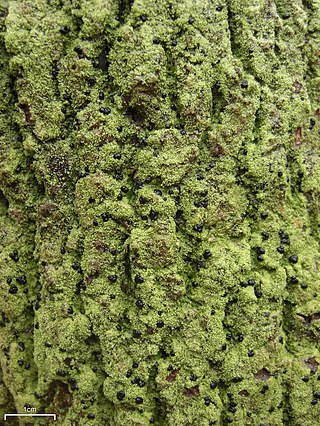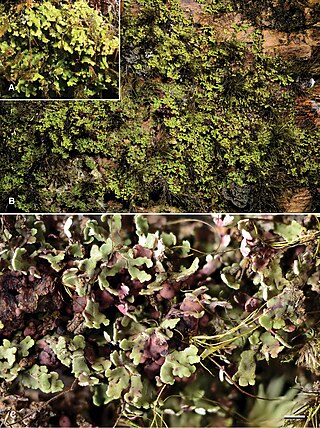
Bacidia is a genus of lichen-forming fungi in the family Ramalinaceae. The genus was circumscribed by Giuseppe De Notaris in 1846. Species in the genus are crust-like lichens with stemless apothecia; they have green algae (chloroccoid) as photobionts. Their asci have 8 colorless, cylindrical to acicular, multiseptate spores, with curved and thread-like conidia.
Aciculopsora is a genus of lichens in the family Ramalinaceae. It was circumscribed by lichenologists André Aptroot and Marie Trest in 2006.

The Physciaceae are a family of mostly lichen-forming fungi belonging to the class Lecanoromycetes in the division Ascomycota. A 2016 estimate placed 19 genera and 601 species in the family.

Diorygma is a genus of lichen-forming fungi in the family Graphidaceae. The genus was circumscribed by Franz Gerhard Eschweiler in 1824. Species of the genus are widely distributed in tropical and subtropical regions of the world.
Physcidia is a genus of lichen-forming fungi in the family Ramalinaceae. The genus was circumscribed in 1862 by American lichenologist Edward Tuckerman.

Krogia is a genus of corticolous lichens in the family Ramalinaceae. It occurs in tropical humid forests and rainforests. The genus was circumscribed by Norwegian lichenologist Einar Timdal in 2002, with Krogia coralloides assigned as the type species.
Toniniopsis is a genus of crustose and squamulose lichens in the family Ramalinaceae. The genus was circumscribed by Swiss lichenologist Eduard Frey in 1926, with Toniniopsis obscura designated the type and only species. The genus name of Toniniopsis is in honour of Carlo Tonini (1803–1877), who was an Italian chemist and botanist (Lichenology), who worked in Verona and was a member and President of the Academy of Agriculture. As a result of molecular phylogenetic studies, several species, formerly classified in genus Bacidia, have been transferred to Toniniopsis.

Cryptothecia is a genus of white to greenish crustose lichens that grow on bark, wood, or leaves. in tropical or subtropical areas worldwide. It has a conspicuous prothallus that develops around its periphery which can be bright red in some species, hence the common name wreath lichen. The main vegetative body (thallus) lacks a cortex (ecorticate and is often immersed in the substrate or byssoid. The medulla is white, well defined, and often peppered with calcium oxalate crystals. Ascomata are not well defined, being cushions of soft white mycelium immersed in the medullary tissue, hence the name from the Greek krypto = "to conceal" and theke = "a container or sheath". There are about 45 described species in the genus according to one source, and 75 species according to another. The genus is in the family Arthoniaceae. It contains Trentepohlia, a green alga, as its photobiont partner.
Pseudopyrenula is a genus of lichen-forming fungi in the family Trypetheliaceae.
André Aptroot is a Dutch mycologist and lichenologist.

Malmideaceae is a family of crustose and corticolous lichens in the order Lecanorales. It contains eight genera and about 70 species.

Malmidea is a genus of crustose lichens and the type genus of the family Malmideaceae. It was established in 2011 to contain a phylogenetically distinct group of species formerly placed in the genus Malcolmiella. Malmidea comprises more than 50 mostly tropical species that grow on bark, although a few grow on leaves.
Sprucidea is a genus of four crustose lichens in the family Malmideaceae. Similar to the related genus Malmidea, Sprucidea is characterized by frequently red thalli that contain the secondary compound norsolorinic acid, but differs in the rod-shaped instead of ellipsoid ascospores and in the stalked sporodochia as conidiomata. Sprucidea species are found in rainforest areas in South America and Southeast Asia.
Wirthiotrema is a genus of lichen-forming fungi in the family Graphidaceae. The genus was circumscribed in 2010 by Eimy Rivas Plata, Klaus Kalb, Andreas Frisch, and H. Thorsten Lumbsch, with Wirthiotrema glaucopallens assigned as the type species. Wirthiotrema contains species that were formerly considered part of the Thelotrema glaucopallens species group. The genus name honours lichenologist Volkmar Wirth, "for his numerous outstanding contributions to lichenology".
Myriostigma is a genus of lichens in the family Arthoniaceae. The genus was circumscribed by German lichenologist August von Krempelhuber in 1874.
Lecania sessilisoraliata is a species of saxicolous (rock-dwelling), crustose lichen in the family Ramalinaceae. It is found on rock outcrops in the mountainous Burdur region of Turkey.
Crustospathula amazonica is a species of corticolous (bark-dwelling), crustose lichen in the family Ramalinaceae. Found in South America, it was formally described as a new species in 2014 by lichenologists André Aptroot, Marcela Cáceres, and Einar Timdal. The type specimen was collected by the first two authors from the Parque Natural Municipal de Porto Velho, where it was found growing on the smooth bark of a tree in a primary rainforest. It also occurs in French Guiana and Peru, and tends to grow in association with lichens of the genus Porina and with thelotremoid members of the family Graphidaceae. The lichen has a film-like, green thallus consisting of fine, aggregated granules; no prothallus is present. Soredia are whitish, roughly spherical, and occur at the tips of cartilaginous stalks up to 3 mm tall.
Physcidia striata is a species of corticolous (bark-dwelling), microfoliose lichen in the family Ramalinaceae. Found in South America, it was formally described as a new species in 2014 by lichenologists André Aptroot, Marcela Cáceres, and Einar Timdal. The type specimen was collected by the first two authors from the Estação Ecológica de Cuniã (Rondônia), where it was found growing on the smooth bark of a tree in a primary rainforest. It also occurs in Peru. The thallus of the lichen is a loose mat of squamules (scales) without a hypothallus. Its lobes are smooth, flat, branched, and greyish-green, measuring 2–7 mm long by 0.5–1.5 mm wide. The species epithet striata refers to the faint longitudinal striations that are present on the lobe undersides. Isidia occur on the thallus surface; they are the same colour as the thallus, with dimensions of 0.3–0.7 mm long by 0.1–0.2 mm wide. When they are abraded, it reveals the whitish colour of the underlying medulla. The lichen contains divaricatic acid, a lichen product that is revealed with the use of thin-layer chromatography.
Gintarasia is a genus of lichen-forming fungi in the family Graphidaceae. It has seven species, all of which are found in Australia. Gintarasia species are corticolous (bark-dwelling), crustose lichens with a thelotremoid form.





